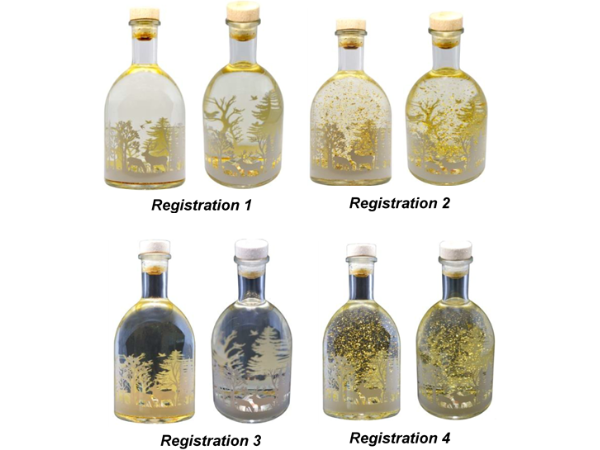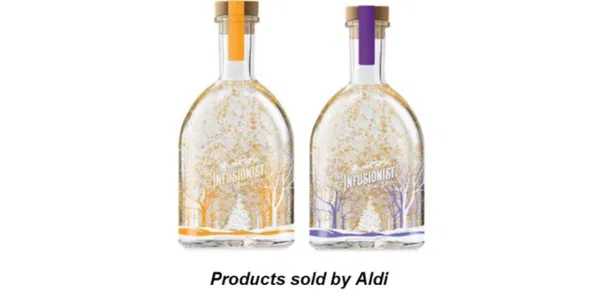The decision previously handed down by the Intellectual Property Enterprise Court (a division of the High Court) that Aldi infringed a number of registered designs by M&S directed towards gin bottles containing suspended gold flakes and a light incorporated in the base of the bottle has been upheld by the Court of Appeal, with Lord Justice Arnold, Lord Justice Moylan and Lord Justice Lewison dismissing Aldi’s appeal.
This decision is a welcome outcome and provides reassurance for designers who choose to invest in research and development of new designs and to secure IP protection for them. What is also clear is that it is not necessary to create a brand new product category in order to obtain protection and to succeed in enforcing those rights against third parties.
The decision is also a timely reminder, hot off the heels of the Thatchers Cider Company v Aldi Stores [2024] EWHC 88 (IPEC) from 24 January 2024 (here), of the value of having a diverse array of registered protection in your IP portfolio. In the Thatchers decision it was held there was no trade mark infringement or passing off by Aldi because there was no likelihood of confusion between the Thatchers cider and the Aldi lookalike. Brands have found it similarly difficult to succeed in other trade mark infringement and passing off cases against lookalikes over the years. Designers of lookalikes are savvy – they get close to the line but often do not cross it. They often also use branding elements and names that differ significantly from the originals which then presents difficulty in getting over the consumer confusion hurdle in trade mark law. This can be frustrating for brands who invest significantly in innovative product development particularly as it is often accepted that the lookalike has been “inspired by”, and in some cases, designed by reference to the original. It helps in this case that the Aldi products are very close to the M&S designs. However, it also goes to show the benefit of being able to run design infringement arguments against lookalikes and not rely solely on trade mark infringement (which is perhaps more common). The gold standard would be having registered trade mark, registered design and copyright protection (the latter arising automatically) so that one can rely on more than one right, or pick and choose which claim is the strongest depending on the specific facts in each case of infringement.
It is also important to note that because M&S were relying on registered design rights, there was no requirement to show that Aldi had copied their designs, which would have been the case if M&S were seeking to rely on unregistered design rights or copyright. As stated above, this sometimes is evident in lookalike cases in particular. But it is an additional evidential burden nonetheless that not only needs to be won but can increase the costs of litigation. Not needing to jump this hurdle is an added bonus in registered designs cases.
We set out our more in depth analysis of the case below and if you would like more information or to speak to our experts in this area please contact Mike Shaw on mshaw@marks-clerk.com.
Background
The registered designs filed by M&S claimed a bottle having a winter artwork applied to its exterior; the liquid inside the bottle comprising suspended gold flakes; and the bottle having a light source in its base. In two of the designs the images of the bottle are taken against a darker background where it can be seen the bottle is illuminated from a light source in the base of the bottle.
Aldi’s appeal sought to challenge the earlier decision on the basis of a number of interesting legal points.
What the Design Registration Images Show

In the earlier decision, the Judge (HH Judge Hacon) found that the two registrations (registrations 3 and 4) with images against a dark background show an integrated light feature and not a dark coloured bottle or a dark liquid. Aldi argued that the Judge gave no reasoning for concluding that the “images [were] created against a dark background” and was wrong to do so, and that the designs should in fact be interpreted as a dark coloured bottle and/or a dark coloured liquid.
The Court of Appeal considered this issue and concluded that Aldi’s position was incorrect, in that registrations 3 and 4 do not show a dark coloured bottle because one can see the glass is clear at the top of the bottle where the stopper is visible, at the neck of the bottle and the base of the bottle. The Court of Appeal also concluded that designs did not depict a dark coloured liquid in a clear bottle because no gap between the top of the liquid and the stopper is visible and because, at least in the square-on images, the printed scene on the reverse side of the bottle is as crisp as the scene on the front.
The Court of Appeal also found that all of the registered designs show an internal light in the base of the bottle, consistent with the earlier decision, illustrated for example by the golden shimmer appearing at the neck of the bottle.
Interestingly, when considering if the bottles contained an internal light and a dark coloured bottle and/or liquid, the Court of Appeal confirmed that it was appropriate for the court to inspect example products sold by M&S. Aldi tried to argue that products manufactured by M&S to which the design was applied were irrelevant to the interpretation of the design, but the court stated this was incorrect. Inspection of the products sold by M&S was able to aid in the assessment of the overall impression of the designs at issue because the M&S products only differ from the designs in that the neck of the bottle bears a “watch-strap” label of the same kind as the Aldi products.
Indication of Product and Description
In UK registered designs the provision of a description is optional, and if provided does not affect the scope of protection.
In the earlier decision, the words “Light Up Gin Bottle” were provided under the description, and the Judge did not reach a conclusion whether the description could be relied upon to resolve an ambiguity as to what is shown in the image of a registered design.
However, in the appeal proceedings, the register had been changed slightly in that the words “Light Up Gin Bottle” now appeared under the heading “indication of product”. The UKIPO explained that it had updated its online registered designs viewing tool because it had become aware that “indication of product” information being provided by applicants was being mislabelled as a “description” on the online viewing service.
The Court of Appeal thus considered if the “indication of product” can be relied on to resolve ambiguity as to what is shown in an image, and in that sense to assist in the interpretation of the design.
This Court of Appeal decision refers back to case law of the EUIPO (European Intellectual Property Office) and the General Court of the EU, and found that the “indication of product” can be relied upon to resolve an ambiguity as to what is shown in the images, and to assist in the interpretation of the design.
As such, a key take-away point from this decision, is that the indication of the product can be used not only to ensure, as far as possible, that a third party searching designs in a given category is able to find a relevant design registration, but that it may also assist in interpretation of the design itself.
The Big Question - Do Aldi’s products infringe?
In short - yes. But, why? Grace Period
Grace Period
In the appeal proceedings, Aldi argued that disclosures of the designs by M&S during the grace period should be taken into account when assessing infringement, because the law relating to the grace period only provides for such disclosures to be disregarded when assessing the validity of the designs.
The Court of Appeal endorsed the Judge’s earlier decision that the purpose of the grace period would be substantially defeated if disclosures of the same design by the designer during the grace period were relevant when considering infringement, since it would essentially restrict the scope of protection granted by the design, which appeared to be contrary to the intention of the grace period provisions.
The Court of Appeal further found that other designs which may be the same or do not produce a different overall impression marketed by the designer during the grace period should also be disregarded when assessing infringement and validity.
An intriguing point set out in this judgment, and something which designers should bear in mind, is that designers may choose to market a number of variants of a design in order to test the market, but then only choose to register one design. If following this approach, designers must accept the risk that the other designs, which are not registered, may in some cases affect the scope of protection of the registered design if they produce a different overall impression from that of the registered design.
Overall Impression
When assessing infringement of a registered design it has to be considered whether the designs of Aldi’s products produce on the informed user a different overall impression to each of the registered designs, considered separately. When making this assessment, a well-known test is followed which is set out in Cantel Medical (UK) Ltd v ARC Medical Design Ltd [2018] EWHC.
In the earlier decision it was found that the Aldi bottles share the following common features with the M&S designs:
- the bottles are identical in shape;
- the stoppers are identical in shape;
- the presence of winter scenes on the straight side of the bottle, and mostly of tree silhouettes;
snow effect; and - an integrated light.
The earlier decision acknowledged that there were the following differences:
- the Aldi bottles have scenes in white and a colour, with trees only; the Aldi winter scene is busier and brighter;
- the Aldi bottle has the “Infusionist” branding, giving the Aldi bottle a front whereas the registered designs have no branding;
- the Aldi stoppers have a watch strap label; the registered designs do not. The Aldi stoppers are also darker in shade.
Aldi argued that the Judge in the earlier decision had not properly considered the impact of the absence of the snow effect and the integrated light on the comparison with respect to the registered designs, which did not include those features. Secondly, Aldi argued that the Judge had given undue weight to the shapes of the bottles and stoppers, particularly given that the shape of the bottle was protected by a third party registered design and that the design corpus included bottles with similar stoppers.
The Court of Appeal did not accept any of these arguments presented by Aldi. The Court of Appeal considered it irrelevant that the shape of the bottle was protected by a third party registered design apart from the fact that the design therefore formed part of the design corpus which was correctly taken into account.
The Court of Appeal can only intervene if the first instance Judge erred in law or in principle. The Court of Appeal found that the first instance Judge made no error of principle in comparing the overall impressions of the Aldi gin bottles with those of the registered designs. As such, the first instance Judge’s conclusion was one he was fully entitled to reach i.e. that the registered designs are valid, that the Aldi gin bottles produced the same overall impression as that of the M&S registered designs, and therefore that the Aldi gin bottles infringe.
Further insights from Mike Shaw on the case have been published by Drinks International here.



